#national army museum
Text


From one special visit, to another…
Last week we were lucky enough to have 'The Hoff' David Hasselhoff and Kiwi home-grown legend Rhys Darby visit the Museum… together! What a real treat! That'll be a day we won't forget soon.
Were we smitten? 😍 Yes! Did we do a little dance after the photo? Absolutely! Did we put on a special David Hasselhoff music playlist in the cafe? Tempted, but no we restrained ourselves. Thanks for stopping by guys! We hope (really hope) to see you back for another visit in the future.
Did you know that Rhys Darby served in the NZ Army in the early 1990s first as a Regular Force Cadet (Williams Class) and then in the Royal New Zealand Corps of Signals?
Source: National Army Museum Waiouru New Zealand
44 notes
·
View notes
Text
21 June 2023
You’re In The Army Now
London
21 June 2023
It was an early start today - I was out the door just after 7.30, catching the Victoria Line to Oxford Circus and the Bakerloo to Paddington. It was already very busy, but there was a laurel at the end of my journey to make braving rush hour a little bearable. It look me a little questioning of staff before I knew whether or not my journey was in vain - it wasn’t - and then I proceeded to sit on Platform One for an hour because I’d massively overestimated how early the train would enter the station. And what locomotive, pray tell, would I go to all this trouble for?
If you know your trains, you could probably make an educated guess.
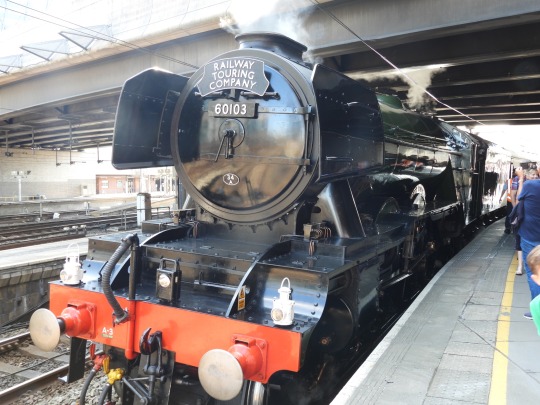
Built a century ago this year, No. 4472 - ahem, 60103 Flying Scotsman needs absolutely no introduction. Today she is the Kardashian of locomotives - she is famous for being famous. Unlike the Kardashians, that fame is well earned - namesake of the famed Flying Scotsman express, first non-stop run from London to Edinburgh in 1928, first (sort of) authenticated 100mph by a steam locomotive in 1934, one of the first privately preserved steam locomotives. She toured the United States (even though we don’t like to talk about how that one nearly ended) and Australia, making the longest non-stop run by a steam locomotive ever between Parkes and Broken Hill. To her detractors, she’s the ‘flying moneypit,’ bankrupting every owner since 1963. To her fans, she’s the most famous steam locomotive in the world, Sir Nigel Gresley’s masterpiece. And at long, long last, I have seen her in steam.
Basically, do you know how monarchists get really excited about seeing the King? This is my version of that.
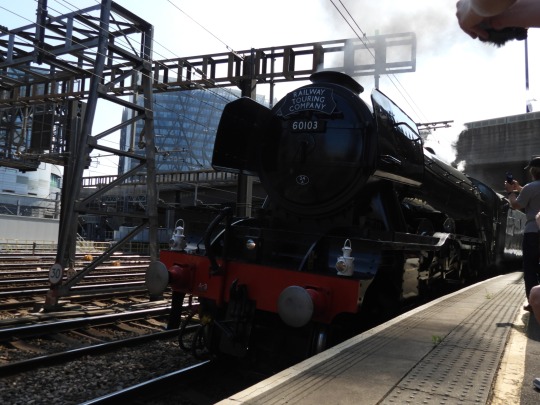
After her departure at 9.40, I headed on the Circle Line to Sloane Square, walking through Chelsea and past the famed hospital there to the National Army Museum. The NAM is basically the cooler, hipper IWM, in my opinion. It perhaps benefits from a narrow subject matter; specifically Britain, and specifically the British Army. Without becoming too complicated, it does a much better job at contextualising its exhibits than the IWM, without shying away from the controversies and horrors of war. Do you think, for example, that the Australian War Memorial would stock a book about the massacre of Surafend, in the way the NAM stocks one on the British organised mass slaughter of Amritsar?
When I talk about museums, as you probably know by now, I like to mention an exhibit that struck me, and the exhibit in question at the NAM was more recent than you might expect. While I could discuss the saw that amputated the Earl of Uxbridge’s leg again - the fact that it still exists makes me very happy - I’ll instead mention a ruined L85 rifle from the Middle East, which was recovered from a vehicle destroyed by an IED - none of the passengers survived. Jay Winter has said that if one shows a weapon in a museum, they ought to show what it does. Here, in this ruined weapon, we see both at once. We don’t need to see the blood and bones of the soldiers; from this broken rifle, we can fill in the gaps as to the horrific power of explosives ourselves.
Also, the NAM cafe does a mean scrambled eggs.

After the Army Museum, I headed back to the tube and caught the Circle Line again to St. James’ Park, where I walked to the Guards Museum. This is a small museum that people don’t really know about, and that surprises me as it’s literally right across the road from Buckingham Palace - it’s in Wellington Barracks, where the guards march from during the Changing of the Guard.
The Guards Museum is a very old-school and classic museum; a British Army regimental museum in the same old style that I love so very, very much. The museum is both wide in scope and intimate in subject matter - this isn’t the story of the army or the wars it fought, but the part played by the five regiments of the Foot Guards - the Grenadiers, the Coldstream, the Scots Guard, the Irish Guard and the Welsh Guard. For the majority of the British Army’s history, there were only the first three - oddly, the ‘1st’ (Grenadier) Foot Guards are actually the youngest, but as they were Charles II’s personal guard, they got to be senior after the Restoration in 1660.

There were a lot of very interesting things in this museum, but I’m going to highlight something very boring instead. There’s a shako worn by a soldier of the Coldstream Guards in the late 1820s - it’s called a bell-top shako. Guards shakos from this period are very rare, because they were introduced in 1829 and dropped in 1831, when all of the Guards regiments adopted the bearskin cap of the Grenadiers. In fact, this shako was so rare that I didn’t actually know it existed - I’d assumed that the bearskins were adopted soon after Waterloo, but it seems the Coldstream and Scots Guards kept the shakoes of the regular infantry for just a little bit longer. This is a completely, utterly useless factoid, but I find it absolutely fascinating.
Across from the Guards Museum is the Guards Chapel, and to the uninitiated it looks strangely modern. Surely regiments as old as the Guards ought to have a similarly old chapel, right? Well, they did - until the morning of 18th June 1944, when it suffered a direct hit from a German V-1 flying bomb in the middle of a morning service. 121 were killed, and over 140 injured. The new chapel is not only a memorial to the men of the Household Division (the Foot Guards and the Household Cavalry), but to those killed in the bombing. I was initially the only visitor, and by the time I left only a small group of Americans - who I will say were very respectful - had joined me there. Dozens of regimental colours from throughout the Guards histories hang from the walls. I almost felt like an intruder in another family’s mausoleum.
I’m not religious, but for some reason I was moved to light a candle.

I walked from there, back past Buckingham Palace and down Lower Grovesnor Place, to a small memorial on the side of an intersection near Victoria. This is a curious little monument - it’s explicitly a memorial to the Great War, yet the Tommy on top is joined by a pair of riflemen from the Napoleonic and Crimean Wars respectively. This is the memorial to the Rifle Brigade, the progeny of the famed 95th Rifles of Wellington’s time (although a number of Rifle Brigade battalions could trace their heritage to the 60th Rifles as well.) After the Second World War, it was adapted to commemorate the riflemen lost in that conflict.

I visit a lot of memorials because I think they are interesting, or because I simply find them in the wild. I hunted down this one because it was important to me personally. This isn’t because I think the 95th were cool or because I watch a lot of Sharpe, or because green is my favourite colour and riflemen wore green uniforms. My nan had two uncles, one who fought in the First World War and one who fought in the Second. Both were riflemen - the first of the ‘Hackney Rifles’ and the second of the 7th Rifle Brigade. The first was wounded at Third Ypres, although I’m not certain how severely. The second still lies to this day in Florence, lost in the attacks on the Gothic Line in September 1944. It’s silly, and probably vulgar, but I’ve always seen the Rifle Brigade as ‘ours.’ I probably confused a lot of London commuters by pointing at a random monument in the middle of the city, repeating over again - ‘that’s us. That’s us.’
Yet it is us. The memory agents, the people who lived through the First World War, are all dead. The people who lived through the Second will still follow. It is now up to us to interpret their memory, their experiences, their histories and their stories. We have a responsibility to them.
Like it or not, this is us.
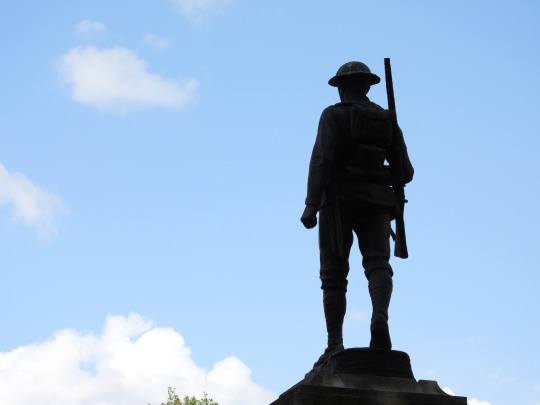
I then wrecked this profound emotional moment by having a big fanboy moment over a Routemaster bus, and then I walked back to the hotel. After a brief rest, I reunited with my mum and stepdad, who had been very kindly invited by my professor to join the group at the garden party of the Britain-Australia Society at the Royal Over-Seas League’s London HQ. It was all very sophisticated, with a lot of the great and good - and Joe Hockey - present, but I think it just didn’t quite gel with me. We stayed for a socially acceptable amount of time, then went back to Victoria Station and grabbed some McDonalds before parting.
We will reunite in Paris, but there’s a long road ahead to get there…
#flying scotsman#national army museum#guards museum#rifle brigade#first world war#second world war#napoleonic wars#crimean war
18 notes
·
View notes
Text






I thought the old timey militia laundry at the River Raisin was an interesting demonstration of camp life during the War of 1812. They even found the wettest, most bedraggled-looking Kentucky militiaman impression for that authentic touch! Realistically, you should have a lot of men on fatigue duty (or mending their clothes) if you are portraying a War of 1812 military force.
The older gentleman portraying a military surgeon was a delight. He was very knowledgeable about all of the period medical technology and techniques, and he also does American War of Independence events (if he looks familiar to anyone). He explained that laudanum couldn't be used for anaesthesia prior to surgery because of the difficulty of accurate and effective dosing.
#summer of 1812#war of 1812#living history#military history#historical reenactment#historical reenactors#river raisin#river raisin battlefield national park#dressed to kill#us army#state militias#kentucky militia#battle of the river raisin#michigan#history of medicine#i got a sneak peek at some very cool exhibits under construction at the museum!#i have more summer of 1812 pictures than i know what to do with
46 notes
·
View notes
Photo
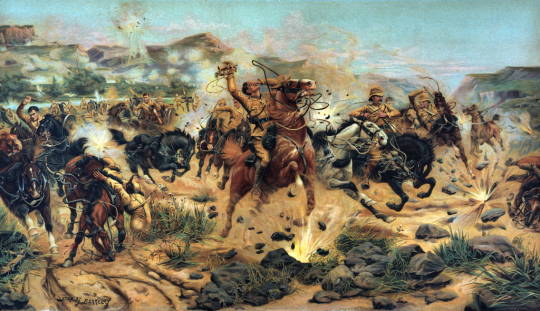
Saving the Guns at Colenso, 1899 (chromolitho) by Stanley Berkeley
chromolithograph, 1899 National Army Museum, London
#Stanley Berkeley#fineart#art#painting#artwork#masterpiece#fineartprint#gallery#museum#guns#colenso#national#army#london#national army#enemy#enemies#war#shooting#horse#fight#action
2 notes
·
View notes
Photo
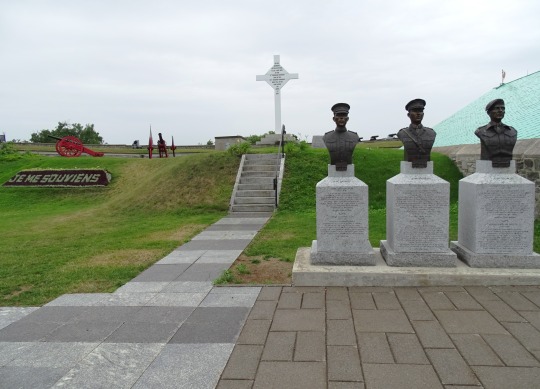


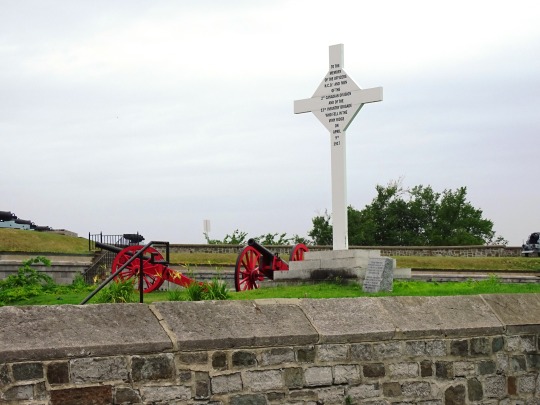
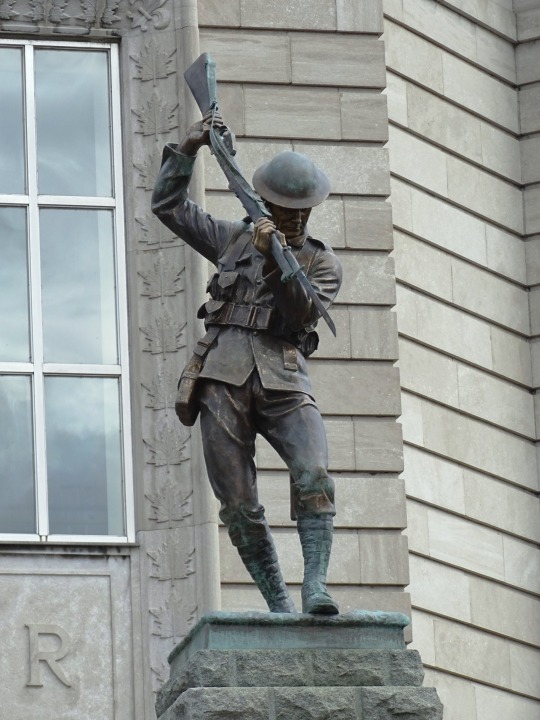

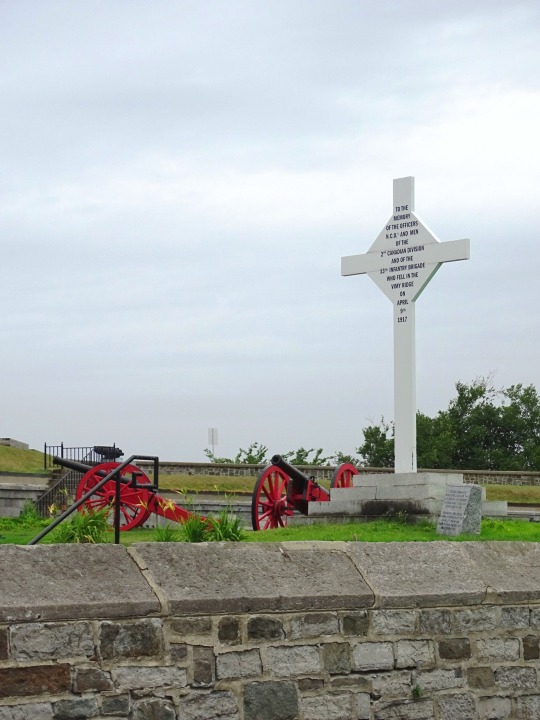


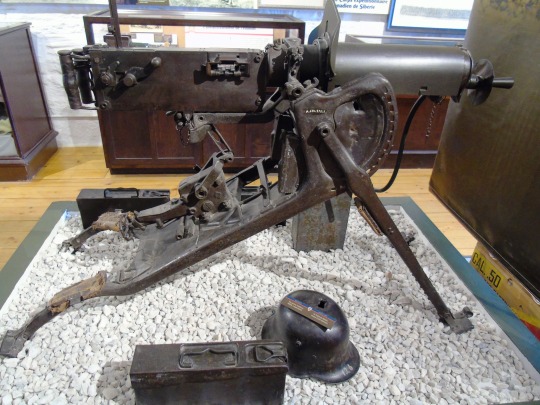
World War I: Canadian forces successfully completed the taking of Vimy Ridge from the Germans on April 12, 1917.
#National War Memorial_The Response by Vernon March#Vimy Ridge Cross#The Road to Vimy and Beyond#Royal 22e Régiment Museum#Citadelle of Quebec#Quebec City#Québec#Ottawa#Ontario#Canada#summer 2018#2015#original photography#Trois-Rivières#citysccape#travel#Monument to the Brave by Cœur-de-Lion McCarthy#Army Museum Halifax Citadel#taking of Vimy Ridge#12 April 1917#anniversary#Canadian history#WWI#World War I#World War One#Fort George#Halifax Citadel National Historic Site of Canada
4 notes
·
View notes
Text
why are they only available at the physical bnf in fucking paris i'm gonna go insane
1 note
·
View note
Text
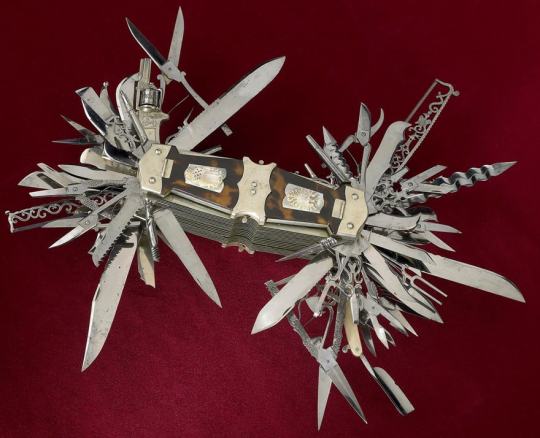
This 19th-century multi-tool from Germany has 100 different blades and a .22-caliber five-shot revolver.
This knife could be described as the Mother of all Swiss Army knives. If you count the miniatures inside the tortoise shell handle covers, it has 100 “blades.” They include pocket knife blades of every style imaginable, a serrated blade, two dagger blades, several different types of shears and scissors, an auger, a corkscrew, two saws, a lancet, button hook, cigar cutter, tuning fork, pens and mechanical pencils, mirror, straight razor, and a functional .22-caliber five-shot pinfire revolver. The one modern convenience it doesn’t seem to have is a bottle opener, but the bottle cap as we know it wasn’t invented until 1892.
Source : National Museum of American History
2K notes
·
View notes
Text
If you read the novel Catch-22 (1961), about U.S. Army pilots & sundry stationed on a Greek island during World War II, you will encounter this off-hand description during the period where Yossarian is hiding in the field hospital:

At which you will either pause worryingly, or you’re normal.
I am not normal, because I have watched the television show M*A*S*H (1972-1983), about U.S. Army medical staff in a mobile surgical unit during the Korean War, and which features a character called Hawkeye Pierce, who frequently looks like this:

Now this bathrobe, iconic simply, appears red to the observer. However, deep into the run there is a line in which Hawkeye refers to it as "purple"—great consternation. But film cameras and light waves being what they are (capricious, devilish), it could very well be maroon in life. It could very well be maroon. It’s what I assumed after that comment. But what I'd never asked was, what is it made out of? Is that corduroy, could it be corduroy, could this be—

Oh noooooooo!
Why is Hawkeye the only one who is wearing the robe of patients from the last war, I ask you! Is it for the METAPHOR. To make me YELL. Did the costume department make it for him, or did they just already have one on hand in the WWII storage? Wait it wasn't real was it? Where is it, where is this robe!
Well babe, it’s in the Smithsonian:

A) of all, fucking fantastic, could not be a place I more want Alan Alda’s bathrobe as Hawkeye Pierce to be than the National Museum of American History. B) well well well well well, what do we have here:

[sic]
So looking THAT up brings you nothing that makes any sense, even trying to correct for spelling. But not to fear: historical re-enactors are here.
On the website of the “WW2 US Medical Research Centre,” an absolutely delightful combination of words and spelling brought to you by two European history buffs, and that’s Europeans who are obsessed with history, specifically American medical units in the 1940s, there’s a page for pajamas, and why look who’s here:

OH ho oh HO!
“Progressive Coat & Apron Mfg. Co.” is so similarly bizarre that I would be very willing to bet that something like idk, the imperfect process of digitizing thousands of records for a website catalog, could have absolutely resulted in “Agressive Coat and Manufacturing Company.” Which would mean yeah, yeah yeah: vintage World War II, slash Korea, just five years later. It was authentic, what they gave Alda to wear, along with his dog tags.
Just Hawkeye though still, which is what's odd.
BUT HANG ON.
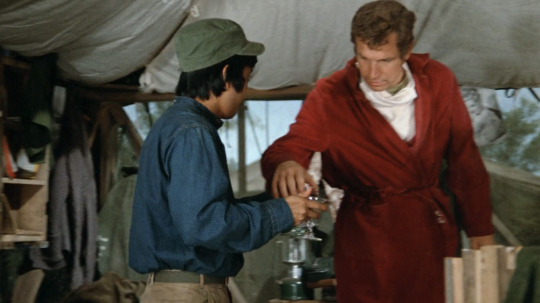
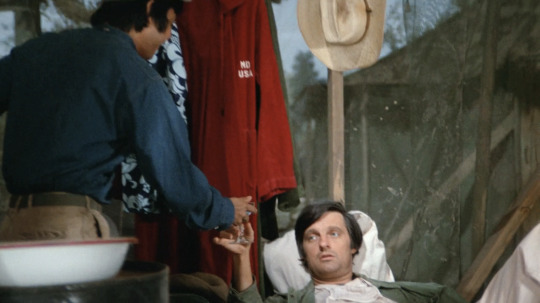
Heeeeey now!
So I was recently reminded that in the pilot episode, but the pilot episode only, Wayne Rogers as Trapper John McIntyre also has the regulation corduroy MD/USA bathrobe! In fact, he actually has what would appear to become Hawkeye’s—observe the location of the embroidery. Pocket, like Hawkeye’s in every robe appearance after this first episode, the robe that ends up in the Smithsonian Museum. Whereas the one with the embroidery on the chest that's hanging above Hawkeye's cot here, a common variant that shows up when you’re searching around on military history websites, after this appearance I believe is seen just once more on a visiting colonel later in the first season, then quietly vanishes. Alda ends up in Trapper's, and stays in it for keeps, while Rogers gets, of all things, a cheery goldenrod terry number.
But like, why. Why just Hawkeye in the WWII surplus robe. Both Doyle and Watson have avenues here that I like to think about. For the Doylist side, I suspect it was a decision of like, this is simply too matchy. It’s 1972, our TV screens are small, we gotta take any chance we can get to distinguish these tall white men constantly wearing the same of two monochrome outfits.
In fact, I actually wonder if there was a world where Trapper might have stayed in the maroon and Hawkeye could have ended up in Henry’s robe.
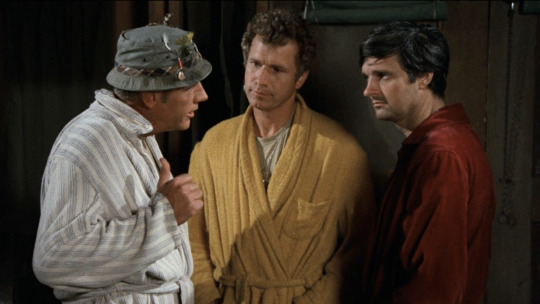
The light blue & white striped bathrobe McLean Stevenson wore as Henry Blake was sold at auction in 2018, and the item description contains the curious detail of it having a handwritten tag inside reading “Hawkeye.” Well heeeyy again.
And here’s another curious detail:

There was a blue & white striped Army-issue robe as well
Now Henry’s is clearly NOT vintage WWII, lacking the pocket embroidery, being terry cloth, and also of course: pastel. But it’s INTERESTING, isn’t it? They had to have been GOING for that look, with that same unusual collar shape and that multi-stripe patterning.
(Also, for real 'what the hell even IS this color' fun, this militaria collectors purveyor has one of the maroon versions too, with photos you can page though and laugh as it flips between looking clearly purple and clearly red in every other photograph. Cameras!!!)
Anyway now we turn to the Watsonian explanation, which seems to run like this: the men at the 4077 were just casually passing their robes around to each other. It's about the intimacy in the face of war, etc. I can see bathrobes going missing when they bug out, getting stolen from the laundry by Klinger and scrapped for parts, being handed off to a poor cold Korean kid who needs it more, and then they need to get to the showers and one of them is like hey, just take mine, and then it’s his now. And eventually most of them end up in warmer-looking civilian robes than the Army holdovers that were being distributed early on, but Hawkeye, he just hung on to Trapper's.
And as a side effect, still looks like he's been injured in World War II.
#thank you for going with me on this journey#and thank you in particular: to Joseph Heller#really froze me in place at that line buddy#M*A*S*H#M*A*S*H hours#Catch 22#Joseph Heller#WWII
1K notes
·
View notes
Text
i literally spend at least 2 hours a week just looking at various pictures of the terracotta army. utterly entranced. look at the details in the hair. you'd never see ANY of this when they're lined up in formation, but they're there.
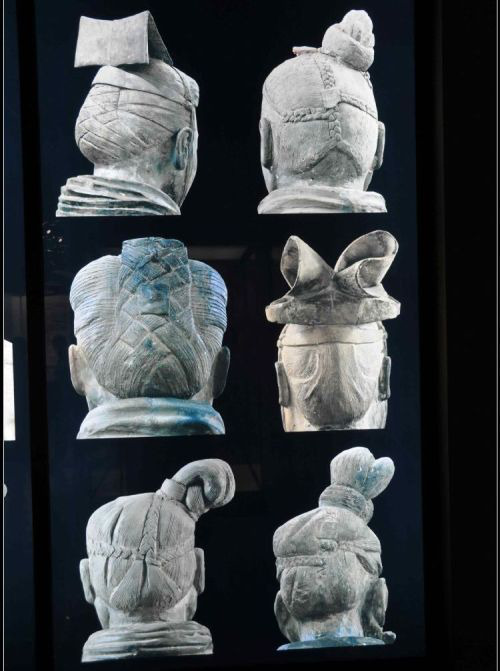
theres about 8000 of these guys down there, no two faces are alike. they're works of art. they're the manifestation of a cruel despot's delusions of grandeur. a talisman against the terrible inevitability of death, both pathetic and strangely pitiful. like watching a child clinging to his blanket, begging you not to turn off the light. they were a bunch of insignificant clay statues from a side chamber that was so small and unremarkable, no one bothered to write down the location. they were modelled after real people. their only purpose was to serve qin shi huang in the afterlife, so he could reign in heaven as he did on earth. now the emperor is just a ghost and his pawns are immortal. my dad and i visited them in the dead of winter, on a weekday, just so we wouldn't have to deal with tourists like us. the place had easily 500 people--not including the ones below ground. we traveled to xian via the old "green skin" diesel train. there are faster means, like highspeed rail but dad insisted i try the authentic way, the same way he would have traveled when he was my age it was also like, a quarter of the price but im sure that had nothing to do with it! back in the 80s carriages would get so packed people had to have their luggage passed in via the windows. as we chugged along, i read my book and my dad made us cup noodles. car is just a shortened version of "carriage", the word is the same but the mechanism is different. it's the same in chinese. i think if i told someone from the warring states period i could travel from the Kingdom of Qi to Qin in just four hours with my metal carriage, i'd be laughed out of town--or accused of being a spy and sentenced to 'death by carriage.' we hopped off the train at 4am and took a different "carriage." the taxi driver joked; "basically every dynasty put their capital in xian, stick a shovel anywhere and you'll turn up some national treasure or another." i wonder what it would have felt like to be a farmer digging a well and then out pops a remarkably realistic human head. statistical analysis show the soldier's faces bear a strong similarity to people living in the region today. the taxi stopped in front of a jewellery-hawking tourist trap and refused budge an inch until we went inside. did you know the terracotta soldiers were originally multi-coloured and painfully gaudy, just like the greek marbles? they were made assembly-line style. the arms and legs were made from the same workshops that made clay plumbing pipes and roof tiles. for quality control, the artisans were required to stamp their names. the workers who built these tombs were executed shortly afterwards, because only dead men can be trusted with secrets. qin shi huang's mausoleum is unlikely to be excavated in my father's lifetime, or mine, not unless i'm willing to take a BIG ONE for the team... instead of the tomb, they built some kind of qin shi huang-themed theme park next to it. not only was it tacky as hell the entrance fee was like $50. we went to the museum and i looked at bronze tools and pottery shards for three hours. look why can't we just crack the thing open i can't be the only one here whos dying from curiosity what if we all just took turns digging
#qin shi huangs terracotta army#warring states#qin dynasty#thinking about Her...<3 bronze tools and pottery shards <3#my writing
1K notes
·
View notes
Text


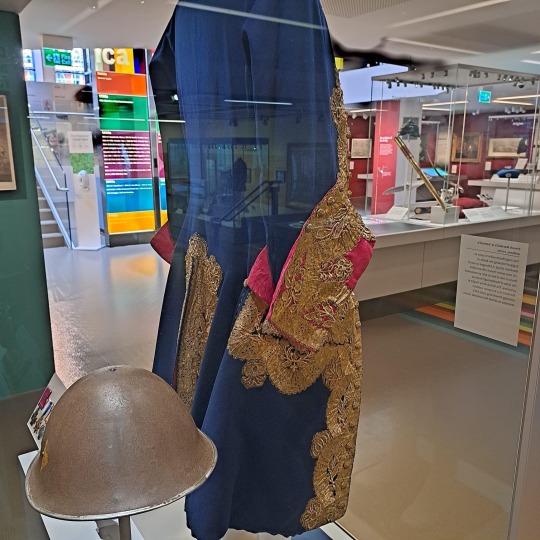
The uniform of a senior French general, captured at the battle of Blenheim in 1704 and now forming part of the exhibition at the National Army Museum.
#history#british army#french army#military history#18th century#battle of blenheim#blenheim#duke of marlborough#marlborough#war of the spanish succession#louis ix
370 notes
·
View notes
Text






'The Monymusk Reliquary', The National Museum of Scotland, Edinburgh
This is one of the most important early Christian objects to survive in Scotland.
Made in the 8th century CE, nothing more is known about it until it was first recorded as being at Monymusk House, Aberdeenshire in 1859. Initial interpretations argued that it was a reliquary of St Columba called the 'Breac Beannach'.
Medieval texts speak of the 'Breac Beannach' being carried into battle to protect the Scottish army. Exactly what this object was is unclear, but its Old Gaelic name 'brecc bennach' translates as 'the glittering peaked one'. 'Peaked' was sometimes used figuratively for the gable of a house. However there is no proven link between St Columba and this unique casket.
#early religion#reliquary#archaeology#relic#artefact#symbols#early christianity#christianity#metalwork#Scotland#monymuskreliquary
187 notes
·
View notes
Text
[Hanfu · 漢服]Chinese Song Dynasty(960–1279AD)Emperor Traditional Official Hanfu











The official uniform of the Chinese Song Dynasty emperor in "Serenade of Peaceful Joy"




【Historical Reference Artifacts】:
Portrait of Emperor Taizu (21 March 927 – 14 November 976)of Song Dynasty, kept in the National Palace Museum

Portrait of Emperor Yingzong (16 February 1032 – 25 January 1067) of Song Dynasty, kept in the National Palace Museum

Many people may curious about why the emperors of the Song Dynasty did not wear the classic yellow, but instead wore white or red round-necked robes.
During the Han and Tang dynasties, yellow was exclusively associated with imperial authority. According to the theory of "the Wuxing (Chinese philosophy)"which is Fire, Water, Wood, Metal, and Earth, yellow represented the center and symbolized the legitimacy of imperial power. However, during the Song Dynasty, due to political changes, Emperor Taizong decided to shift this tradition and adopt red as the new symbolic color for the dynasty. The court officials supported this change and provided various justifications, such as the theory of fire's virtue and the idea of red being a color of celebration, among others.
During the Han and Tang dynasties, yellow was exclusively associated with imperial authority. According to the theory of "the Wuxing (Chinese philosophy)"which is Fire, Water, Wood, Metal, and Earth, yellow represented the center and symbolized the legitimacy of imperial power. However, during the Song Dynasty, due to political changes, Emperor Taizong decided to shift this tradition and adopt red as the new symbolic color for the dynasty. The court officials supported this change and provided various justifications, such as the theory of fire's virtue and the idea of red being a color of celebration, among others.
【Emperor Taizu of Song Dynasty<Zhao Kuangyin/赵匡胤>】
Emperor Taizu of Song (21 March 927 – 14 November 976), personal name Zhao Kuangyin, courtesy name Yuanlang, was the founding emperor of the Song dynasty of China. He reigned from 960 until his death in 976. Formerly a distinguished military general of the Later Zhou dynasty, Emperor Taizu came to power after staging a coup d'état and forcing Emperor Gong, the last Later Zhou ruler, to abdicate the throne in his favor.
During his reign, Emperor Taizu conquered the states of Southern Tang, Later Shu, Southern Han, and Jingnan, thus reunifying most of China proper. To strengthen his control, he lessened the power of military generals and relied on civilian officials in administration. He was succeeded by his younger brother, Zhao Kuangyi (Emperor Taizong).
Early life
Born in Luoyang to military commander Zhao Hongyin, Zhao Kuangyin grew up excelling in mounted archery. Once, riding an untamed horse without a bridle, he knocked his forehead on the wall above the city gate and fell off, but got right back up and chased the horse, eventually subduing it while going unharmed. In the mid-940s, he married Lady He on his father's arrangement. After wandering around for a few years, in 949 he joined the army of Guo Wei, a jiedushi (military governor) of the Later Han dynasty, and helped Guo quell Li Shouzhen's rebellion.
Career under Later Zhou(后周)
In 951, Guo Wei rebelled and created the Later Zhou dynasty. Because of his brilliant combat skills, Zhao Kuangyin was promoted to a palace guard commander. Chai Rong (Emperor Shizong of Later Zhou) frequently met Guo Wei and noticed Zhao Kuangyin's potential. Under his command, Zhao Kuangyin was made into a commander of the cavalry units. Under Chai Rong, Zhao Kuangyin's rise to power had begun.
Zhao Kuangyin's career started at the Battle of Gaoping, against the alliance of the Northern Han and Liao dynasties.
This rivalry started when Chai Rong ascended the throne and Liu Chong decided to work with the Liao dynasty. In the initial confrontation, the army's right flank, led by Fan Aineng (樊愛能) and He Hui (何徽), was defeated. Looking at the situation, Zhao Kuangyin and Zhang Yongde (張永德) led 4000 elite Palace troops to counter the Liao army. Zhao Kuangyin's exhortation for the loyalty to the emperor quickly strengthened morale. The small force held off the larger Liao army until reinforcements arrived. In the end, the successful counter repelled the Northern Han back to Taiyuan.
The victory raised Zhao Kuangyin up to the post of the grand commander of the palace guards, as well as reorganising and training them. More importantly, he developed the relations with other generals and officials related to the Chief of Palace, including Shi Shouxin, Wang Shenqi (王審琦), Yang Guangyi (楊光義), Wang Zhengzhong (王政忠), Liu Qingyi (劉慶義), Liu Shouzhong (劉守忠), Liu Yanrang (劉延讓), Mi Xin (米信), Tian Chongjin (田重進), Pan Mei, his brother Zhao Kuangyi, Shen Yilun (沈義倫), Lu Xuqing, Zhao Pu (趙普), Chu Zhaofu (楚昭輔). Within a few years, Zhao Kuangyin completely controlled the palace guards and even developed a set of officials under him with the people mentioned above.
Soon, he was promoted to a jiedushi (military governor), controlling most of the military power under Chai Rong. Nevertheless, he still had two rivals – Zhang Yongde (Guo Wei's son-in-law) and Li Chongjin (Guo Wei's nephew). In 959, after a trap[clarification needed] set by Zhao Kuangyin, Zhang Yongde was demoted. After the death of Chai Rong, the Later Zhou throne was left to his seven-year-old son Guo Zongxun, and the second rival, Li Chongjin, soon found himself lacking the political backing. As a result, Zhao Kuangyin was able to use his influence to transfer Li Chongjin to Yang Prefecture as a jiedushi.
Chenqiao Mutiny/陈桥兵变
Main article: Chenqiao Mutiny20th-century illustration of Zhao Kuangyin being proclaimed emperor by the army of the Later Zhou dynasty.
In 960, word reached the chancellor Fan Zhi that Northern Han and Liao dynasties were once again allied to invade them again. Without verifying the reliability of the hearsay, Fan Zhi sent Zhao Kuangyin to combat the alliance. After traveling 40 li, there was a clamour that a "prophet" saw two suns fighting, and that this meant the transfer of the Mandate of Heaven to Zhao Kuangyin. The story effectively spread around the army: there came discontent of the "command" of the young emperor and a shift of loyalty to Zhao Kuangyin. A few days later, when Zhao Kuangyin was drunk in his tent, all the troops had not slept the whole night; they got their weapons and started yelling. Zhao Pu and Zhang Kuangyi, who were guarding the tent, saw the situation and went into the tent to wake up Zhao Kuangyin. When Zhao Kuangyin came out, all the troops yelled, "The army is without a master, we are willing to make the general the new emperor." Allegedly, Zhao Kuangyin took the power reluctantly, only under the urging of his soldiers. The midnight mutiny of officers forcibly urged Zhao Kuangyin to the throne; but, when the officers presented him to the troops as their new commander-in-chief he refused the imperial nomination until they swore unconditional obedience to him as leader.[6] News of the rebellion soon reached the court and chaos erupted. The only person who thought about a resistance was Han Tong, but he was killed by one of Zhao Kuangyin's generals when he reached home.
Upon entering the capital to take his seat on the throne, Zhao Kuangyin made an executive order prohibiting the troops from looting the city or otherwise violating the rights of the population.
This coup would allow Zhao Kuangyin to become emperor in 960.With the gates opened for him, he became emperor with no resistance. Before the chancellor Fan Zhi could say anything, one of Zhao Kuangyin's generals pointed a sword at him and said, "We are without masters. Today, we must have an emperor." After the officials looked at each other and knew it was hopeless to resist; they all bowed down. With the court under control, Zhao Kuangyin was officially proclaimed emperor. The new dynasty's name, Song, was inspired by the army Zhao Kuangyin commanded in Song Prefecture.
After the declaration, Zhao Kuangyin sent the dethroned young emperor Guo Zongxun with his mother to the Western Capital (西京). He personally ordered the Zhao family to receive the Chai family into their family's care for generations.
As emperor
Emperor Taizu playing cuju with Zhao Pu, by the Yuan dynasty painter Qian Xuan (1235–1305)
In 960, Zhao Kuangyin helped reunite most of China proper after the fragmentation and rebellion between the fall of the Tang dynasty in 907 and the establishment of the Song dynasty. The plan set during Chai Rong's reign was to first conquer the north, then the south. During Emperor Taizu's reign, there was a change in strategy. He would conquer all the smaller states such as Later Shu, Southern Han and Southern Tang. The exception was the strong Northern Han in the north at Taiyuan supported by the Khitans of the Liao dynasty. Emperor Taizu's strategy was to win over the independent southern states[8] as the south was weaker than the north as the Liao dynasty supported Northern Han.
In 968, Emperor Taizu personally led the army against the Northern Han. At first, his forces tore through the defences and placed Taiyuan under siege, but was ultimately forced to retreat after he struck against the defences of the Northern Han with the Liao cavalry coming in to support.Portrait of Emperor Taizu, who founded the Song dynasty
Emperor Taizu established the core Song Ancestor Rules and Policy for the later Song emperors. He was remembered for his expansion of the imperial examination system such that most of the civil service were recruited through the exams (in contrast to the Tang where less than 10% of the civil servants came through exams). He also created academies that allowed a great deal of freedom of discussion and thought, which facilitated the growth of scientific advance, economic reforms as well as achievements in arts and literature.
Emperor Taizu is well known for bringing the power of the military under control, ending the era of the warlords, centralizing the state over regional commanders and so preventing anyone else rising to power as he did.[8] Upon becoming emperor, he invited the general officers to a lavish banquet, where he convinced them all to retire as military leaders or accept minor posts, in favour of enjoying extensive estates and generous retirement funds and benefits which he then offered them.At a certain point during the feast, the new emperor made a speech to the military officers assembled there, which he began by expressing his deep gratitude to each and all of them for placing him on the throne, and that now that he had the power to do so, he wished to reward them to the utmost of his ability; then he went on to say that he thought the present company would all understand that he could not feel at ease on his new throne, with them continuing in command of their various armies of troops: and, he said, that if they duly considered the ramifications of the matter, neither would they. He then sincerely promised that they and their families would live in happiness and harmony, if they accepted his offer to retire with the stated benefits: eventually, none of the generals refused his terms, and thus began a period of relative internal peace within the realm for the duration of the Song dynasty which he thus founded, also better securing the military forces for involvement with the rival surrounding empires.
Many Song and later sources record the story of the "Taizu's Oath", which forbade his successors from killing scholar-officials. However, this story might be a later construct.
Death and succession dispute
Tomb of Emperor Taizu in the Yongchang Mausoleum, Gongyi, Zhengzhou
Emperor Taizu reigned for seventeen years and died in 976 at the age of 49. Curiously, he was succeeded by his younger brother, Zhao Kuangyi (Emperor Taizong), even though he had two grown sons – Zhao Dezhao, the Prince of Yan (951–979), and Zhao Defang, the Prince of Qin (959–981). The traditional historical accounts place emphasis on the role Zhao Kuangyin's mother played in the decision which was made shortly after the Song dynasty was proclaimed (around 961). So for nearly his entire reign, it was known and accepted that Zhao Kuangyi would succeed him.
In folklore, the story known as "shadows by the candle and sounds from an axe" is very popular and suggests that Emperor Taizu was murdered by his brother, who was after the throne.After his death, Taizu was interred at the Yongchang Mausoleum, near Gongyi.
After Emperor Taizong, the line of succession passed on to his son and descendants rather than those of Emperor Taizu. However, when Emperor Gaozong (1127–1161) failed to produce an heir, he selected a descendant of Emperor Taizu to be his adopted heir to succeed him in 1161. After 1161, all the subsequent Song emperors were descended from Emperor Taizu through his two sons, Zhao Dezhao and Zhao Defang.
—————————–
📸Photo::©胶宗模玩jiaotoys(Chinese manufacturing historical figure model merchant)
🔗Xiaohongshu App:https://www.xiaohongshu.com/user/profile/5659f093589de33cb53e0083
—————————–
#chinese hanfu#Song Dynasty(960–1279AD)#Emperor Taizu of Song Dynasty#hanfu#hanfu accessories#hanfu_challenge#chinese traditional clothing#china#chinese#yuanlingpao#mens hanfu#mens headwear#胶宗模玩jiaotoys#漢服#汉服#中華風#Serenade of Peaceful Joy
100 notes
·
View notes
Text
Until she fled Bangladesh on Monday, Prime Minister Sheikh Hasina governed as if she still had full legitimacy, even as students and protesters had been on the streets for days asking her to resign. The trigger for the demonstrations—civil service job quotas for Bangladeshi freedom fighters and their families—had become a distant memory. Collective anger about years of human rights abuses, corruption, and rigged elections had coalesced into an uprising.
In a conversation over the weekend, Zonayed Saki, the left-leaning leader of the Ganosamhati Andolan party—himself a student activist against military rule in the 1990s—said, “The people’s sentiment is that she has to go first. The government had lost moral and political legitimacy.”
Hasina believed that she was elected democratically. She won an unprecedented fourth term in a flawed vote in January, which most of the major opposition parties had boycotted and the United States, the United Kingdom, and human rights groups criticized for not being free or fair. Still, other major governments congratulated Hasina on the victory. The bureaucracy, the media, the police, and the army were on her side. What could go wrong?
Over the weekend, Hasina declared a curfew again, cut off the internet, and encouraged the youth wing of the ruling Awami League party to take to the streets. Trigger-happy security forces, who were blamed for the deaths of more than 200 people as the protests turned violent in mid-July, were out in full force. Nearly 100 more people died over the weekend, including 14 police officers; video emerged showing security forces shooting point-blank at nonviolent protesters.
Hasina spoke darkly of Islamists spreading terrorism by co-opting the protests, but the students remained undeterred. A long march was announced for Aug. 5 to demand her resignation. Hasina declared a three-day public holiday in response. But by midday Monday, she had resigned, fleeing the country in a helicopter. The first stop would be India and after that an unknown destination.
Meanwhile, the situation on the ground has turned volatile amid the power vacuum. Thousands of demonstrators rushed to the Ganabhaban, the prime minister’s official residence in Dhaka, looting souvenirs and frolicking on the premises. People have also reportedly attacked the home of Bangladesh’s chief justice. There are also reports of the toppling of a statue of Hasina’s father, Sheikh Mujibur Rahman, who led Bangladesh’s independence movement and then ruled the country until he was assassinated in 1975. Mujib’s family home, now a museum, went up in flames in an act of grotesque retribution. These incidents stand in contrast to the disciplined and peaceful demonstrations led by students, who have urged for calm and were seen appealing to the looters to return stolen property.
Bangladesh’s army has called for calm, but it has not yet intervened. The country’s armed forces overthrew elected governments in the 1970s and 1980s and attempted coups in later years. But now, the generals would naturally want to play it safe: They cannot afford to lose the confidence of Bangladeshis and are aware of the deep distrust that Bangladeshis have developed for the armed forces because their political interventions have weakened the country’s democracy.
There is another calculation at play, too: Bangladesh is among the largest suppliers of soldiers to the United Nations peacekeeping forces, and it won’t antagonize the international community by letting its soldiers act at will. (Those peacekeeping arrangements mean the armed forces are less reliant on Bangladesh’s state budget.) In mid-July, when military vehicles with U.N. insignia were deployed on Dhaka’s streets, foreign diplomats rightly complained; Bangladeshi officials gave weak excuses and promised not to use U.N. equipment to settle domestic unrest.
Hasina seemed to have two options: to seek a graceful exit or to dig her heels in and let the troops take all necessary means to protect her regime. In the end, she fled. Where she will settle is unclear. India would pose problems for Prime Minister Narendra Modi; ruling party politicians have routinely criticized undocumented Bangladeshis in India, even creating legislation to identify and possibly deport them. The United Kingdom may be risky for Hasina because while it hosts many Bangladeshi immigrants, they include dissidents forced into exile during her 15-year rule as well as supporters of the opposition Bangladesh Nationalist Party.
Had Hasina dug in, there would have been bloody consequences. Even if the army had shown restraint toward the protesters, there is no telling if Bangladesh’s notorious border guards or the Rapid Action Battalion—which has faced criticism from human rights groups—would have acted responsibly. There has been violence on both sides, but it has come primarily from the Bangladeshi state. As of Monday, as many as 32 children had died, according to UNICEF.
By stepping aside disgracefully, Hasina leaves chaos in her wake. It is crucial that any interim administration restore order quickly, but it can only do so if it has the backing of the army. A list of bureaucrats, civil society veterans, and others who might form the nucleus of such a government has been released, but the situation is too fluid to consider such lists final. In the early 2000s, Bangladesh had an unelected but legitimate caretaker government to help assist its transition to democracy after a military intervention—which it did, paving the way for Hasina’s election in December 2008.
Hasina has long demonized Bangladesh’s Islamist political forces. But Islamic fundamentalist parties have secured more than 10 percent of the vote only once, in 1991; in all subsequent elections, their vote share has been closer to 5 to 6 percent. Most Bangladeshis are Muslims, but they aren’t extremists; in Bangladeshi American poet Tarfia Faizullah’s famous words, when a Pakistani soldier assaulted a Bengali woman in 1971 and asked her if she was Muslim or Bengali, she defiantly said, “Both.”
The song accompanying many videos of the protests last week was from the pre-Partition poet Dwijendralal Ray, a Hindu, celebrating the golden land of Bengal. To see Bangladesh in binary terms—of Muslim or not Muslim—shows a profound misreading of a complex society. It reveals the myopia of external observers, notably analysts close to the current Indian government, who had invested hugely in Hasina and irrationally fear that an Islamic republic is the only alternative to her rule. In so doing, they frittered away some of the goodwill that India had earned in Bangladesh over the years, particularly for its support during the liberation war.
As a result, the current situation in Bangladesh will complicate things for Modi, Hasina’s close friend. His government had invested hugely in their relationship, aiming to build a trade corridor across Bangladesh and seeking Bangladeshi support to curb separatism in northeastern India. This alienated India from Bangladeshis, who expected New Delhi to defend democratic forces in Dhaka. Nobel laureate Muhammad Yunus, whom Hasina condemned and called a “bloodsucker of the poor,” chided India for not doing enough: South Asia is a family, he said in a recent interview, and when a house is burning, brothers should come and help.
With Hasina fleeing, India has lost an ally it thought it could rely on. The road ahead for Bangladesh will be difficult. Expectations will be high, and the people will want early elections. If those are free and fair, a different Bangladesh can emerge. Whether it will be consistent with the liberal, secular, democratic ethos that Bangladesh’s founders fought for remains to be seen.
102 notes
·
View notes
Note
Since youre antifascist, how about you give us a definition of fascism? What exactly makes someone a fascist? (and in case you use terms such as left-wing or right-wing be sure to define them too)
Guess it's been a while since a clever Anon challenged us to define fascism, huh? Right, let's get into it:
Via the United States Holocaust Memorial Museum:
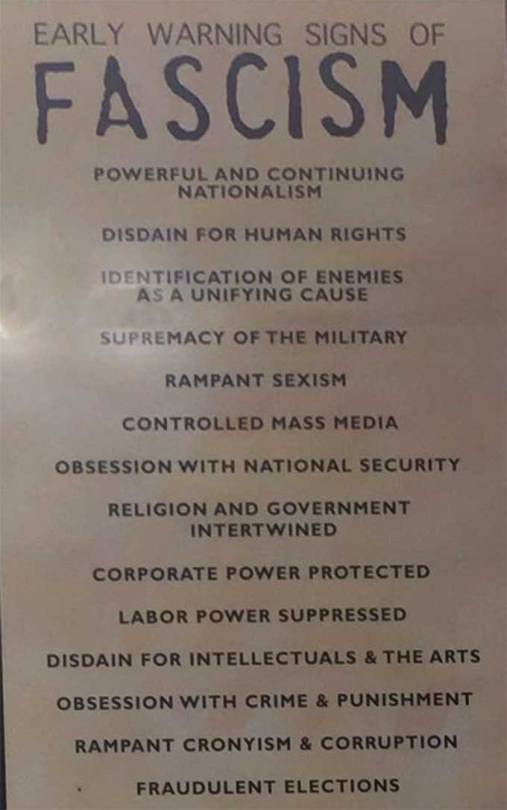
Yale professor Jason Stanley:
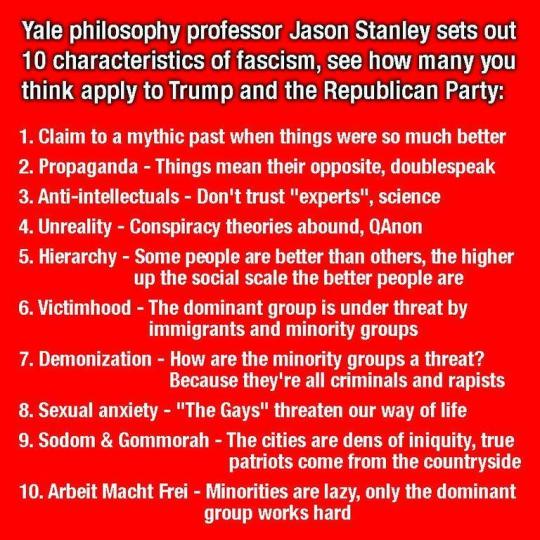
“Fascism is a creation of race hatred and its politically organized expression.” - Willhelm Reich, The Mass Psychology of Fascism (1933).
“Fascism is capitalism plus murder.” - Upton Sinclair
“Repression by brute force is always a confession of the inability to make use of the better weapons of the intellect — better because they alone give promise of final success. This is the fundamental error from which Fascism suffers and which will ultimately cause its downfall…that its foreign policy, based as it is on the avowed principle of force in international relations, cannot fail to give rise to an endless series of wars that must destroy all of modern civilization requires no further discussion. To maintain and further raise our present level of economic development, peace among nations must be assured. But they cannot live together in peace if the basic tenet of the ideology by which they are governed is the belief that one’s own nation can secure its place in the community of nations by force alone. ” - Ludwig von Mises, Liberalism: A Socio-Economic Exposition (1927).
“Spent most of the day reading fascisti leaflets. They certainly have turned the whole country into an army. From cradle to grave one is cast in the mould of fascismo and there can be no escape … It is certainly a socialist experiment in that it destroys individuality. It destroys liberty.” - Harold Nicolson, The Harold Nicolson Diaries : 1919-1964 (2004).
“The liberty of a democracy is not safe if the people tolerated the growth of private power to a point where it becomes stronger than the democratic state itself. That in its essence is fascism: ownership of government by an individual, by a group, or any controlling private power.” - Franklin D. Roosevelt
“A fascist is one whose lust for money or power is combined with such an intensity of intolerance toward those of other races, parties, classes, religions, cultures, regions or nations as to make him ruthless in his use of deceit or violence to attain his ends….If we define an American fascist as one who in case of conflict puts money and power ahead of human beings, then there are undoubtedly several million fascists in the United States.” - Henry A. Wallace
“Fascism is the cult of organised murder, invented by the arch-enemies of society. It tends to destroy civilization and revert man to his most barbarous state. Mussolini and Hitler might well be called the devils of an age, for they are playing hell with civilization.” - Marcus Garvey, Authors take Sides on the Spanish War, 1937
Philosophy Tube's breakdown of the elements of fascism is very thorough and recommended if you're not the reading type.
But do you read books? We hope so if you're looking to engage in political discussion about anything. Here are some books that tackle the definition of fascism, in whole or in part, that we would recommend to you (check/order from your local library!)
Mark Bray's highly-accessible Antifa: The Anti-Fascist Handbook is a great starting point for this topic.

Columbia history professor Robert O. Paxton's excellent book The Anatomy of Fascism goes into this in great detail.
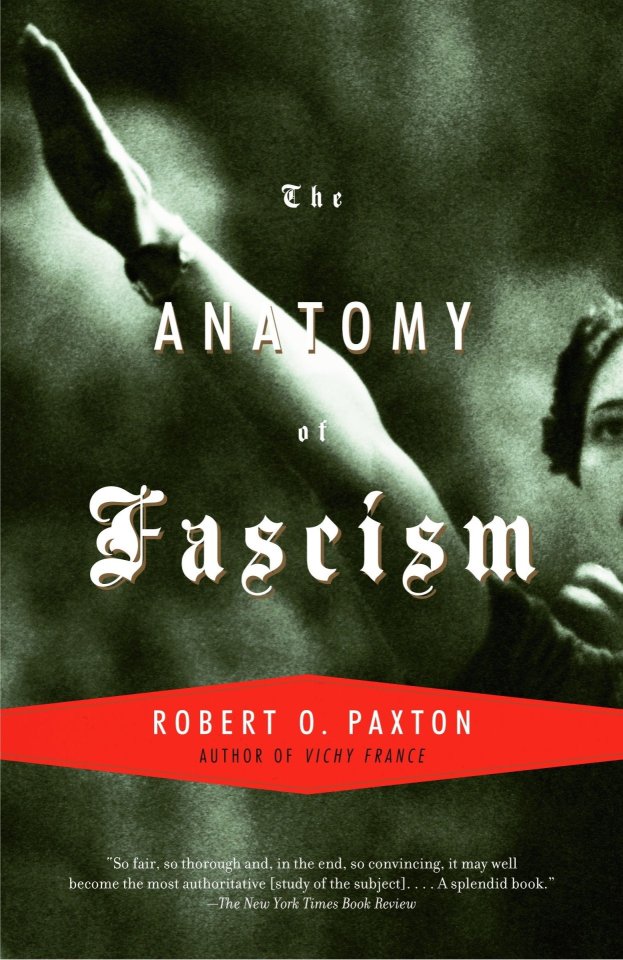
There's also Umberto Eco's The Eternal Fascist

or his "practical list for identifying fascists"
as well as Hannah Arendt's seminal The Origins of Totalitarianism
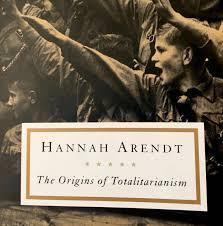
We hope you weren't looking for a simple answer to the complex question of "what is fascism?" Anon, just as we hope you're up to taking our challenge of checking out all of the above so you're curiosity is satisfied and you're well-versed on the topic.
648 notes
·
View notes
Text










France granted 1 km² at Vimy Ridge “freely, and for all time, to the Government of Canada, the free use of the land exempt from all taxes” on June 29, 1922.
#Army Museum Halifax Citadel#Halifax Citadel National Historic Site of Canada#Fort George#Halifax#Nova Scotia#2015#Quebec City#Québec#travel#Citadelle of Quebec#Royal 22e Régiment Museum#Vimy Ridge Cross#The Road to Vimy and Beyond#1 km²#Vimy Ridge#29 June 1922#anniversary#Canadian history#architecture#cityscape#tourist attraction#landmark#original photography#summer 2018#vacation
0 notes
Text
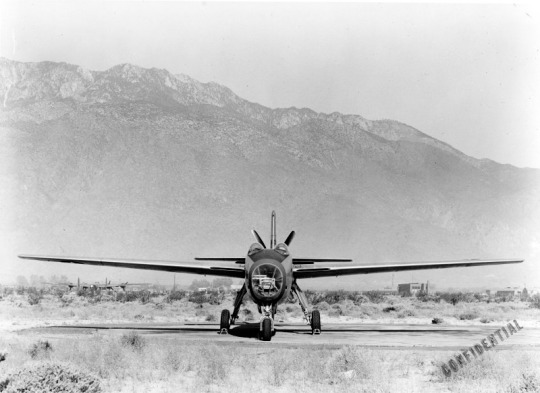
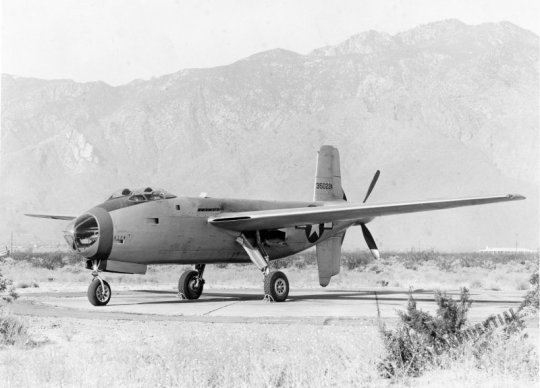


Douglas XB-42 Mixmaster (43-50224) parked on the tarmac, likely at the Muroc Army Airfield, California. This was the first of two prototypes ordered by the USAAF.
Date: May 10, 1944
SDASM Archives: 01_00095105_2, 01_00095103_2, 01_00095104_2
National Museum of the United States Air Force: 061020-F-1234S-001
#Douglas XB-42 Mixmaster#Douglas XB-42#XB-42 Mixmaster#XB-42#B-42#Mixmaster#Bomber#Cancelled#United States Army Air Corps#U.S. Army Air Corps#US Army Air Corps#Army Air Corps#Air Corps#USAAC#World War II#World War 2#WWII#WW2#WWII History#History#Military History#Edwards Air Force Base#California#May#1944#my post
99 notes
·
View notes